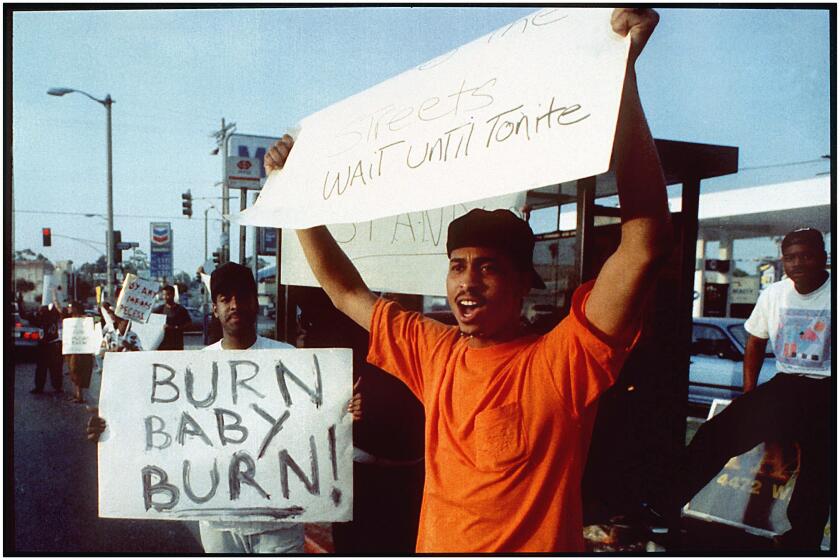‘A crime upon a crime’: Trump’s Tulsa rally gives ‘Watchmen’ episode new resonance
- Share via
HBO’s “Watchmen” begins with a wide-eyed Black boy in a silent movie theater. “There will be no mob justice today — trust in the law,” he says, in full agreement with the words onscreen. What follows is a rude awakening for both the boy and the viewers watching him: a meticulous, minutes-long depiction of the 1921 Tulsa massacre, in which mobs of white people brutally murdered hundreds of Black residents in broad daylight. The thriving district of Greenwood, then referred to as Black Wall Street, was decimated in the span of two days.
When the pilot aired in October, this sequence — filmed in Georgia two years ago on May 31 and June 1, the same dates when the violence took place in 1921 — brought the oft-erased event into wider consciousness. Since then, the Peabody Award-winning series’ focus on race, policing and vigilantism in America has retained its acute relevance, particularly amid the protests against police brutality that have followed the death of George Floyd. In honor of Juneteenth, which commemorates the abolition of slavery in the United States, HBO has made all nine episodes available to stream for free through Sunday on HBO.com and Free On Demand.
Now, as Donald Trump prepares to hold his first presidential campaign rally since the start of the COVID-19 pandemic in Tulsa on Saturday, “Watchmen” executive producer and pilot episode director Nicole Kassell tells The Times that the timing of the event made her “nauseous.” (The rally was initially set to take place on Juneteenth proper, but was moved to Saturday after public outcry.)
Kassell spoke about staging the tragedy with emotion and accuracy and grappling with the reenactment’s newfound resonance — including the decision by Oklahoma’s Education Department to add the massacre to its curriculum for the first time.
Slavery’s end has been commemorated by Black Americans for generations. But on “Atlanta” and “black-ish,” Juneteenth went mainstream.
You filmed the “Watchmen” pilot two years ago. What continues to haunt you about this depiction?
I rewatched the sequence just last week, and I think in light of everything going on and having had some distance from actually directing it, it reduced me to tears. Just imagining you’re living in a country that’s at peace, and your very own neighbors and often employers attack you for no reason. People murdered and homes burned and robbed.
And then was systematically also erased — it’s like a crime upon a crime. It’s just so truly incomprehensible from my point of view, and that it is not shocking or incomprehensible to [the] entire [Black] community is what you know is really coming to light right now and is so disturbing.
How did you feel when you heard that Trump’s rally will take place in Tulsa?
Honestly, I felt nauseous. I just really wanted to vomit. That quote from Kamala Harris articulated it best for me: “This isn’t just a wink to white supremacists — he’s throwing them a welcome home party.”
The level of insult … I keep hoping he’s reached the nadir of his evilness, but he hasn’t. It’s just cruel. To know it’s so calculated and deliberate, that’s what’s very disturbing and scary. I don’t want him getting credit for changing the date [from Juneteenth] by one day. You want to do the right thing, you want to show respect? You don’t hold a rally in that location.
Had you heard about this event before reading the script?
No. Neither had my assistant and I’d say 90% of people who read the script. So many of us were learning about it through the script. We went to the real Greenwood District for research, and it was chilling to go to the blocks where the original stores were that had been burned down.
There were very clear efforts in place to remember and immortalize — little placards in the cement on the sidewalk, a mural — but the most stark thing to see was the plaque for the Dreamland movie theater was right next to an overpass. They did rebuild and become successful again, but it’s like this effort to destroy it never stopped. They literally built a highway through the neighborhood afterward, and that sealed its fate.
The massacre is seen through the eyes of one family. How important was that to get right?
This sequence sets up the whole journey of the show, which is entirely about that little boy’s journey and many generations forward, and how trauma potentially gets passed down from generation to generation.
People say [the depiction] is so surreal or harrowing, and the reason it feels that way is because you’re put so firmly in this innocent point of view. You’re seeing these events through this little boy’s eyes, and it’s that feeling of knowing he can’t unsee these traumatic images. Through him, we are seeing these things that will haunt him for the rest of his life.
The complicated and painful history behind the real-life events depicted in the HBO series ‘Watchmen’ was almost erased from history.
The sequence also has very little dialogue.
Yes. After one take, I realized the range of emotions I needed from the man and the woman was between fear versus determination and strength to complete this journey. Because while they’re terrified and it is a horrific event, there was the Red Summer in 1919, and all these other places where these massacres had happened. So it may have been their first experience of this, but they had heard of this happening elsewhere, which is even more tragic.
Why was it important for you to have the set blessed by a priest?
Full transparency: I’d heard that Ava DuVernay did that when filming the bridge sequence in “Selma.” I did not want to take this responsibility lightly in any way, and it felt like a way to show the utmost respect to both the victims and everyone in the cast and crew who [were] about to go through this reenactment. There was one person in the crew who had an ancestor who had survived the massacre, and that was just chilling.
This was also the first thing we shot of the pilot. I had Damon [Lindelof, the showrunner] write a letter to the cast and crew to give our thanks for what we’re going to do. Just transmitting gratitude and appreciation for everybody the whole way through.
This scene involves 200 actors performing some seriously traumatic stuff.
The degree to which every background actor committed to their performances, and the depth of chaos and horror in each frame, was unbelievable. One of the unusual things we got to do in pre-production is we brought in 50 background actors and stunt actors to rehearse. You almost never get to do that. We taped out the street on a long stretch of Metro Studios outside Atlanta, and they roughed in what the different groups and events and little stories would be.
Those 50 people then became like team leaders for their units of background groups, and they’d work with their department heads. So we had this pyramid structure to make sure everyone was OK throughout the entire process. There were lots of different points of check-in, and nobody was ever alone.
I recently found some photographs of background actors resting between takes, and they’re laughing and smiling. And when we wrapped on the second day, it was the longest goodbye of my life, in a good way, shaking so many hands of so many people. Often, people are just rushing to get home, but everybody took their time to say a real, personal goodbye.
With so many components, how did you capture everything in a tight two-day shoot?
I didn’t want to ask these actors to do these takes too many times. So when we started hard prep in mid-March, we storyboarded the whole thing to figure out just the amount of horror you needed to land the impact and so that it would resonate throughout the whole season, but also making sure never to stay in it longer than needed, otherwise it would tip into gratuitous. It was essential that this never be indulgent or heroic, we just needed to get into the brutal and ugly and get out.
On the day, we ran it almost like a play, and put cameras where we could get the most coverage. Then we did playback and I’d give notes for the next take. We were very prepared, but one improvised decision we made on the spot was having the husband hand the rifle to the wife, and for her to be tempted to use it. He stops her, but I wanted to, just in that body language, tell the story that women were taught how to shoot. She wasn’t afraid of the gun. She’s as much the protector in that situation as he is.
As the Black Lives Matter movement responds to the death of George Floyd, documentarians of the Rodney King uprising discuss the similarities — and differences.
What was the technically trickiest component to capture?
The airplane itself is CGI, and without a drone, figuring out how to indicate to 100 people where to look at the same moment is a little tricky. We honestly just winged it. [First assistant director Keri] Bruno had a loudspeaker and verbally simulated the airplane, and we just had to kind of pray that it’d work. I think there was so much chaos in the sequence that it ultimately was OK if some people are looking at one way and others other ways.
Oklahoma is now adding this massacre to its curriculum for the first time. Did you ever anticipate that this depiction would help influence that?
I definitely didn’t think that far ahead. It’s tremendous to hear that. The ripple effect has been so profound — after the pilot aired, there was something like 500,000 searches for it. At that moment, I felt like whatever came up for the series as a whole, if that’s the only thing we achieve, then it’s been worth every minute. I’m thrilled that so much more has come of it.
For me, it’s important to tell stories that leave people thinking, and hopefully changing. I did have the privilege of shouldering the burden of putting that scene on screen, and while I feel very proud of what we did, there’s that full awareness also that it’s not my story to tell. It’s my story to tell as best I can or to do justice to. So many people have been wanting to tell this story for so long, and I’m grateful that we got to do it as well as we did.
But Greenwood is just one of many, many, many towns that had massacres. There’s so much we need to learn about and commemorate and make reparations for.
‘Watchmen’
Where: HBO.com
When: Any time
Rating: TV-MA (may be unsuitable for children under the age of 17)
More to Read
The complete guide to home viewing
Get Screen Gab for everything about the TV shows and streaming movies everyone’s talking about.
You may occasionally receive promotional content from the Los Angeles Times.








